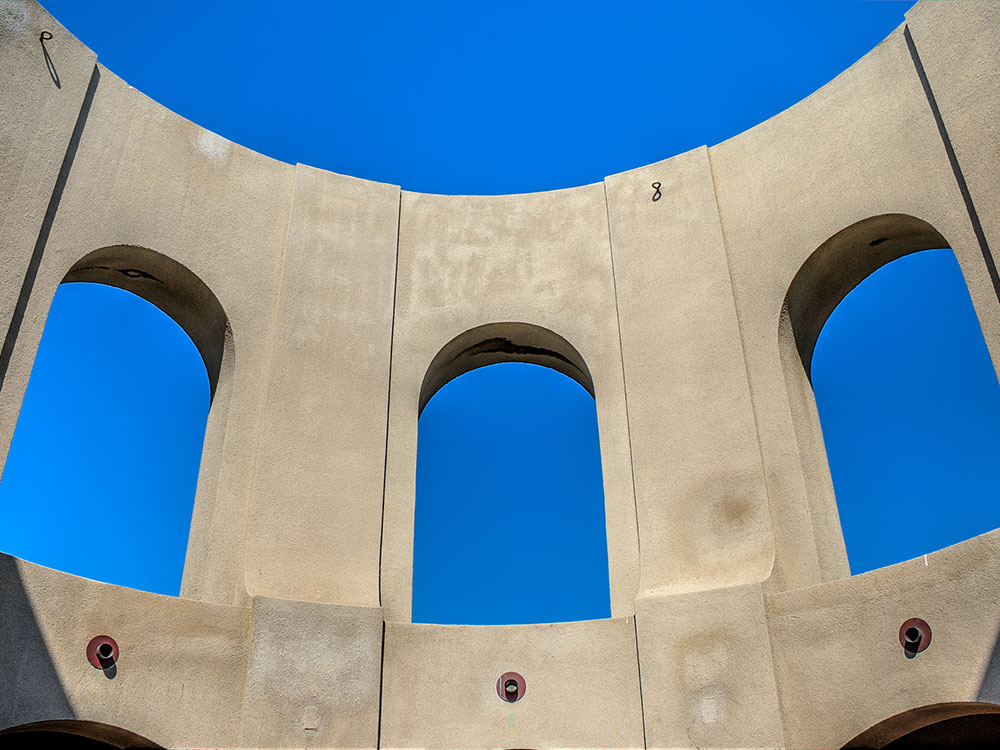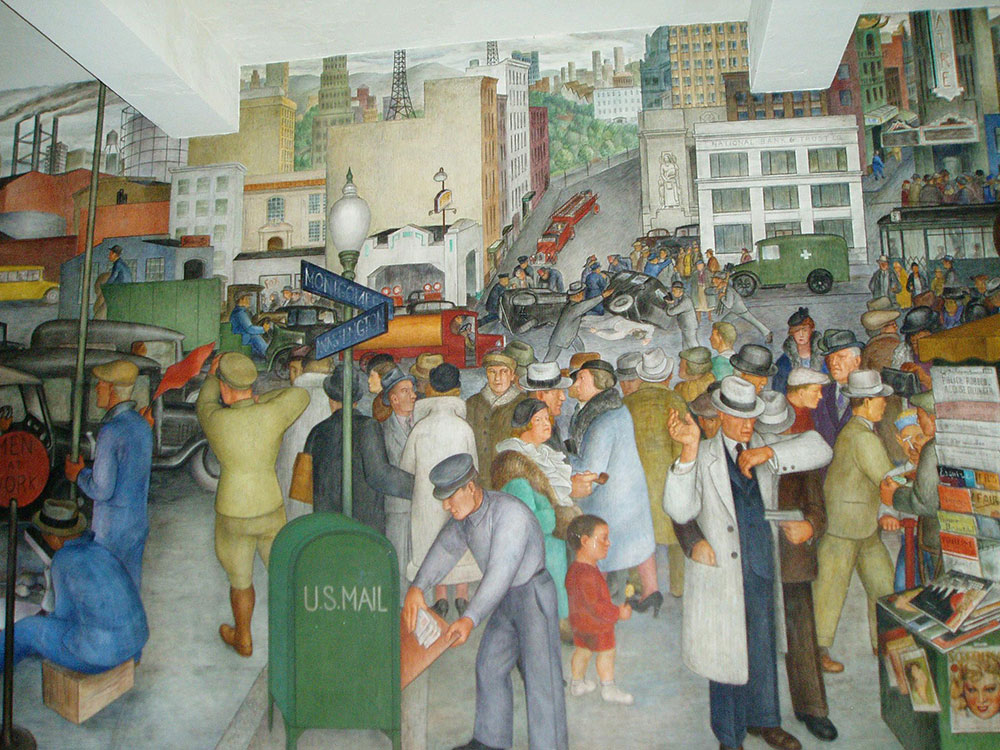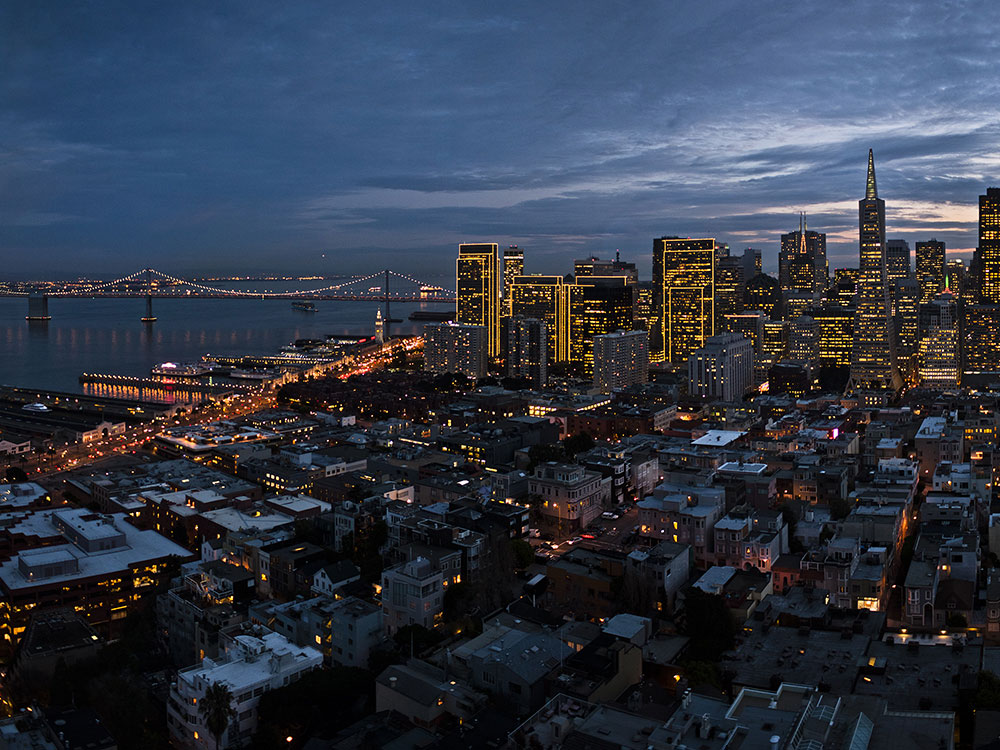210-foot (64 m) tower in the Telegraph Hill neighborhood of San Francisco, offering panoramic views over the city and the bay
April through October: 10am to 6pm
November through March: 10am to 5pm
Closed: Thanksgiving Day, Christmas Day & New Years Day
Adult SF Residents: $7.00; Non-Residents: $10.00
Senior (62+) SF Residents: $4.00; Non-Residents: $7.00
Youth (12-17) SF Residents: $4.00; Non-Residents: $7.00
Child (5-11) SF Reesidents: $2.00; Non-Residents: $3.00
Child (4 & under) SF Reesidents: Free; Non-Residents: Free
* A service fee of $0.50 for SF Residents and $1.00 for Non-Residents(except child 5-11) will be added for pre-purchased online ticket sales
A maximum of 16 tickets will be available per hour, per day. If your ticket is not used at your designated time, it will be valid through March 31, 2022 as a general admission ticket. It will no longer be valid for the special reservation line and yours will be accommodated on a first come first serve basis.
Private Guided Mural Tours - 1st and 2nd Floor: $9.00
Tours have a 4 person minimum/6 Person Maximum
The second story has seven more murals which have been closed to the public for decades, and will be included in your 40 minute tour.
Private Guided Mural Tours - 2nd Floor Only: $5.00
Tours have a 4 person minimum/6 Person Maximum
The second story has seven more murals which have been closed to the public for decades, and will be included in your 40 minute tour.
Take Market St to Larkin St. Continue on Larkin St. Take Leavenworth St to Telegraph Hill Blvd.
Coit Tower is a 210-foot (64 m) tower in the Telegraph Hill neighborhood of San Francisco, California, offering panoramic views over the city and the bay. The tower, in the city's Pioneer Park, was built between 1932 and 1933 using Lillie Hitchcock Coit's bequest to beautify the city of San Francisco. It was added to the National Register of Historic Places on January 29, 2008.

The art deco tower, built of unpainted reinforced concrete, was designed by architects Arthur Brown, Jr. and Henry Howard. The interior features fresco murals in the American Social Realism style, painted by 25 different onsite artists and their numerous assistants, plus two additional paintings installed after creation offsite.
Also known as the Coit Memorial Tower, it was dedicated to the volunteer firemen who had died in San Francisco's five major fires.
Architecture
Brown's competition design envisioned a restaurant in the tower, which was changed to an exhibition area in the final version. The design uses three nesting concrete cylinders, the outermost a tapering fluted 180-foot (55 m) shaft that supports the viewing platform. An intermediate shaft contains a stairway, and an inner shaft houses the elevator. The observation deck is 32 feet (9.8 m) below the top, with an arcade and skylights above it. A rotunda at the base houses display space and a gift shop.
Mural project
The Coit Tower murals in the American Social Realism style formed the pilot project of the Public Works of Art Project, the first of the New Deal federal employment programs for artists. Ralph Stackpole and Bernard Zakheim successfully sought the commission in 1933, and supervised the muralists, who were mainly faculty and students of the California School of Fine Arts (CSFA), including Maxine Albro, Victor Arnautoff, Ray Bertrand, Rinaldo Cuneo, Mallette Harold Dean, Gordon Langdon, Clifford Wight, Edith Hamlin, George Albert Harris, Otis Oldfield, Suzanne Scheuer, Hebe Daum, Jane Berlandina, Frederick E. Olmsted Jr., Jose Moya del Pino and Frede Vidar. These 25 artists (chosen by Walter Heil, director of the de Young Museum, together with other officials) were each paid $25 to $45 per week to depict "aspects of life in California." The most well-known of them were assigned sections that were 10 by 36 feet (3.0 by 11.0 m) in size, while less famous artists were confined to 10 by 4 feet (3.0 by 1.2 m).
The artists were committed in varying degrees to racial equality and to leftist and Marxist political ideas, which are strongly expressed in the paintings. Bernard Zakheim's mural Library depicts fellow artist John Langley Howard crumpling a newspaper in his left hand as he reaches for a shelved copy of Karl Marx's Das Kapital (here spelled as Das Capital) with his right. Workers of all races are shown as equals, often in the heroic poses of Socialist realism, while well-dressed racially white members of the capitalist classes enjoy the fruit of their labor. Victor Arnautoff's City Life includes the periodicals The New Masses and The Daily Worker in the scene's news stand rack; John Langley Howard's mural depicts an ethnically diverse Labor March as well as showing a destitute family panning for gold while a wealthy, heavily caricatured ensemble observes; and Stackpole's Industries of California was composed along the same lines as an early study of the destroyed Man at the Crossroads.
Architecture
The youngest of the muralists, George Albert Harris, painted a mural called Banking and Law. In the mural, the world of finance is represented by the Federal Reserve Bank and a stock market ticker (in which stocks are shown as declining) and law is illustrated by a law library. Some of the book titles that appear in the law library, such as Civil, Penal, and Moral Codes, are legitimate, while others list fellow muralists as authors, in a joking or derogatory manner.
Two of the murals are of San Francisco Bay scenes. Most murals are done in fresco; the exceptions are one mural done in egg tempera (upstairs, in the last decorated room) and the works done in the elevator foyer, which are oil on canvas. While most of the murals have been restored, a small segment (the spiral stairway exit to the observation platform) was not restored but durably painted over with epoxy surfacing.
The view
The tower, which stands atop Telegraph Hill in San Francisco's Pioneer Park, offers panoramic views of San Francisco including "crooked" Lombard Street, Nob Hill, Russian Hill, Twin Peaks, Aquatic Park, Pier 39, the Financial District, the Ferry Building, as well as San Francisco Bay itself including Angel Island, Alcatraz, Treasure Island, and the Golden Gate and Bay Bridges.
This article uses material from the Wikipedia article "Coit Tower", which is released under the Creative Commons Attribution-Share-Alike License 3.0

 [[:en:User:Epachamo|Epachamo]] at the English-language Wikipedia, Public domain, via Wikimedia Commons ; Image Size Adjusted
[[:en:User:Epachamo|Epachamo]] at the English-language Wikipedia, Public domain, via Wikimedia Commons ; Image Size Adjusted-750.jpg) Wgreaves, CC BY-SA 3.0, via Wikimedia Commons ; Image Size Adjusted
Wgreaves, CC BY-SA 3.0, via Wikimedia Commons ; Image Size Adjusted KennyOMG, CC BY-SA 4.0, via Wikimedia Commons ; Image Size Adjusted
KennyOMG, CC BY-SA 4.0, via Wikimedia Commons ; Image Size Adjusted